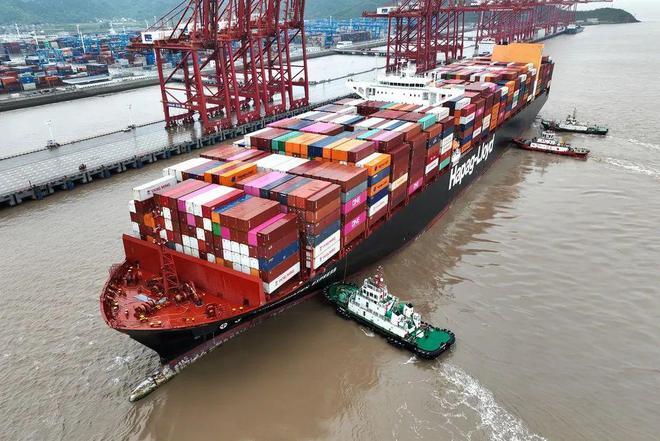From a difficult start to becoming the world's number one, what did China's shipbuilding industry do right?
2024-06-19 19:12
When the Korean shipbuilding industry was at its peak, seven of the top ten shipyards in the world were Korean.
China's shipbuilding industry was once deeply shrouded in the dominance of South Korea's shipbuilding industry. Every competition for orders with South Korea was a "tough battle", not to mention in the field of high value-added ships such as LNG.
But in recent years, the balance of victory and defeat in the shipping industry has reversed. In 2023, China's shipping industry received a lot of orders, and the number of orders for 14 of the 18 ship types ranked first in the world, and the three major indicators of the shipbuilding industry ranked first in the world.
More importantly, China has begun to squeeze into the high-end shipbuilding market, causing the originally unhurried Korean shipbuilding industry to begin to have an urgent "sense of crisis."
As Korean industry insiders said, although South Korea still maintains a global leadership in the field of high-end ship types, in recent years, China has been continuously eroding South Korea's market share in the field of high-end ship types.
The last safe haven for South Korea's shipbuilding industry is being lost.
01
LNG surpasses the competition! Winning 40 billion orders
LNG carriers are one of the three crowns of the shipbuilding industry, on par with aircraft carriers and cruise ships. In the past, South Korea was an undefeated legend and the ruler of LNG (liquefied natural gas carrier) ships. According to media reports, in the past 30 years, a total of 680 LNG carriers have been built worldwide, and South Korean shipbuilders accounted for about 74% of the total.
In 2021, South Korea accounted for 91% of the global LNG ship market, while China only accounted for 9%. In just a few years, China has rapidly risen in LNG ship types. According to Clark data, China's share of the international LNG market in 2023 will increase to 21.62%.
When China met South Korea on a narrow road this year, it actually won the world's largest single shipbuilding order from South Korea!

According to China Shipbuilding Industry Corporation, on April 29, China Shipbuilding Industry Corporation and Qatar Energy Company held a signing ceremony in Beijing for the construction project of 18 271,000 cubic meter ultra-large liquefied natural gas (LNG) carriers.
The total value of this series of ship orders is as high as 40 billion yuan, with an average of 2.22 billion yuan per ship.
The economic value of LNG ships is so high because they are one of the "most difficult ships to build in the world" and face many challenges in their design and manufacturing process.
On the one hand, the structural design of LNG ships must be able to withstand the impact of extreme low temperatures on hull materials, and the hull materials need to have excellent low-temperature resistance to prevent brittle fracture in extremely cold environments. On the other hand, the power supply system and maintenance system of LNG ships also need to be specially designed to adapt to extremely low-temperature environments and ensure the safety of ship operations.
Winning such an important business order means that China has leading strength in the global LNG carrier market and has broken through the foreign technology blockade in LNG production technology.
From being the "world's first" in multiple ship types to a breakthrough in orders for high-end ship types, the shipping industry's first-place prize has come to China.
02China
's shipbuilding industry rides the wind and waves
The development of China's shipbuilding industry today can be described as a thrilling plot, but looking back at the development process, every step has been difficult and tenacious, and it is a way of survival to find a way to break down and then rebuild in the wind and rain.
The Ming and Qing dynasties were the peak period of China's shipbuilding industry and the golden age of Chinese shipbuilding technology. Especially in the construction of wooden ships, China's technology reached the world's leading level at that time.

Wenchang Qinglan Port, where ships were connected in history/data map
However, in modern times, the wars continued, and by the eve of 1949, China's shipbuilding industry was already scarred and dying. Due to China's technological disadvantages, insufficient market demand, poor government financial conditions, lack of talent and technological innovation, wars and political turmoil, and other factors, China's shipbuilding industry gradually fell behind Europe, Japan, and South Korea.
According to data from China Caitong Securities Research Institute, in 2000, China's shipbuilding industry accounted for only 5% of the global market.
The dream of becoming a maritime power has begun to be embedded in China's strategic deployment. By introducing foreign capital, technology and management experience, China has rapidly narrowed the gap in shipbuilding technology with advanced countries.
A wide range of policy tools were used to support the shipbuilding industry. In particular, during the 11th Five-Year Plan period, the shipbuilding industry was designated as a strategic industry, and a series of policy measures were promulgated to provide support in terms of taxation, financing, etc.
In 2001, China joined the World Trade Organization, which also brought new opportunities and challenges to the development of China's shipbuilding industry, and the pace of international cooperation is accelerating.
The Chinese people, who dare to fight and take risks, continued their spirit of struggle in the shipbuilding industry. Shanghai Waigaoqiao Shipbuilding Co., Ltd. completed the construction of 100 ships within seven or eight years of its establishment, creating a "speed myth" in the history of Chinese shipbuilding; Rongsheng Heavy Industries took 28 months from the start of construction to the delivery of the first ship, which was called the "Chinese miracle" in the shipbuilding industry at that time; "Yangtze River Shipbuilding" went from a private enterprise to a listed company in Singapore...
From top to bottom, China has worked together to conquer the shipping industry. Finally, it has achieved multiple breakthroughs in the fields of ultra-large container ships, large liquefied natural gas (LNG) ships, high-end offshore equipment, and core supporting equipment for ships, winning orders and reputation in the global market.
Since 2001, China's shipbuilding completion volume has continued to grow rapidly. By 2010, China's shipbuilding completion volume accounted for 40.4% of the world's share, making it the world's largest shipbuilding country.
According to data released by China's Ministry of Industry and Information Technology in 2023, the new shipbuilding orders received by Chinese shipbuilding enterprises by 2023, in terms of deadweight tonnage, reached 71.2 million tons, an increase of 56.4% over last year. This data indicates that China has accounted for two-thirds of the world's new shipbuilding orders.
At this point, a magnificent epic of overcoming adversity has been written.
03
Game with former champions Japan and South Korea
Looking back at the rise and fall of the world's shipping industry, the champions have changed several times and there have been constant twists and turns.
Before the 1950s, the focus of the shipbuilding industry was in Europe, mainly in the United Kingdom; by the 1950s, Japan gradually became one of the world's shipbuilding centers; after entering the 1970s, South Korea's shipbuilding industry began to gradually rise and maintained its dominant position in the shipbuilding industry for 30 consecutive years.
It was not until 2001 that China's shipbuilding era began.
Due to the combined effects of multiple factors such as changes in the global trade structure and political environment, the Japanese and Korean shipping industries are facing an operational crisis, with some representative companies suffering consecutive losses.
Kawasaki Heavy Industries is one of Japan's largest comprehensive heavy industrial companies. According to Kawasaki Heavy Industries' 2019 financial report, its main shipbuilding and marine business has lost 600 million yen.
In addition, Samsung Heavy Industries, one of the three largest shipbuilding giants in South Korea, has suffered huge losses for eight consecutive years since 2015, amid a decline in the international ship market, low ship prices, rising raw material prices, labor disputes and other factors. It was not until 2023 that it turned losses into profits.
During this period, China started from the "low end", from fishing boats to small and medium-sized cargo ships, and then to bulk carriers and container ships used to transport bulk commodities, and rapidly expanded its market share by relying on its rich product categories and low-cost price advantages.
After 2003, the triangular team of the world's shipping industry began to become unbalanced, with Japan gradually falling behind. In 2008, China surpassed South Korea for the first time in terms of data, and for a full 15 years, China and South Korea repeatedly fought back and forth, taking turns to lead.
It is worth noting that in 2021 and 2022, China quickly seized the market during the boom period of shipping, further consolidating China's leading position. According to Clarksons statistics, Chinese shipyards received a total of 776 orders in 2022, totaling 20.59 million CGT (corrected gross tonnage), accounting for half of the world's total, ranking first in the world.
In terms of the comprehensive competitiveness of the shipbuilding industry value chain in 2023, according to the results of the global shipbuilding industry competitiveness analysis of the Korea Institute for Industrial Economics and Trade, China's shipbuilding industry has risen two places and ranked first in the world.
In the past two years, China's shipbuilding industry has been able to demonstrate its strength. China's shipbuilding industry has formed the ability to assemble and build a full range of ship and marine products. According to People's Daily, in 2023, among the world's 18 major ship types, China ranked first in the world in new orders for 14 types of ship types.
In addition, China's shipbuilding industry has accelerated its intelligent transformation, shortening the design cycle and improving construction efficiency by applying "digital shipbuilding" technology. The average time it takes for Jiangnan Shipyard to build a 20,000-TEU large container ship can be shortened from 28 months to 16 months.
With a complete industrial system and world-leading industrial chain supporting capabilities, the loading rate of supporting equipment such as main engines, boilers, cranes, etc. continues to increase, and the shipbuilding cost is globally competitive... allowing China's shipbuilding industry to continuously improve its winning rate in international competition.
04
It is a super cycle that occurs once every 20 years
Now, China's shipbuilding industry is at a critical juncture in its transition from a large shipbuilding country to a strong one, but it is faced with unprecedented practical challenges and once-in-a-lifetime development opportunities.
The shipbuilding industry is a long-cycle industry. Starting from 2020, the shipbuilding industry will usher in a "new turning point" that occurs once every 20 years.
The mismatch between supply and demand leads to the shipbuilding cycle. Generally speaking, a shipbuilding cycle includes four stages: increasing both quantity and price, flat quantity and increasing price, increasing quantity and flat price, and decreasing quantity and decreasing price.
At the current stage, the market is in a state of volume parity and price increase, which means that although the order volume is increasing, the price of new ships has not dropped significantly, showing the stability of the market and the enhancement of the bargaining power of shipyards.
During this period, the shipping industry was driven by multiple factors, including the demand for replacement due to the expiration of ship age, the implementation of new environmental protection policies, and the gradual recovery of global trade. These factors together caused the prices and order volumes of new ships to begin to rise.
Therefore, for many countries, the shipbuilding industry is a "hot commodity" and a pillar industry that they hope to gain. Ren Yuanlin, chairman of Yangzijiang Shipbuilding, said, "As long as the sea is open, there will be demand for ships and opportunities for shipbuilders."
The shipbuilding industry is a pillar industry in China. It not only generates hundreds of billions of yuan in industrial output value each year, but also creates jobs for tens of millions of Chinese people.
Faced with intensified competition and unprecedented opportunities, Chinese shipbuilding companies must build core competitiveness in technology, quality, price and service, and complete the transformation of a major power mentality from attacking to defending.
05From
a large shipbuilding country to a strong shipbuilding country
Judging from the three major indicators of the shipbuilding industry, there is no doubt that China is the world's largest shipbuilding country.
According to the data released by the Ministry of Industry and Information Technology of China, China's shipbuilding completion volume, new orders and backlog of orders in 2023 accounted for 50.2%, 66.6% and 55% of the world's total in deadweight tonnage respectively, and the market share exceeded 50% for the first time.
China has ranked first in the world for 14 consecutive years in the three major indicators of the shipbuilding industry and is the only country in the world to achieve comprehensive growth in the three major indicators.
However, from the perspective of core competitiveness, China may not be a strong shipbuilding country, because it is still not in the first echelon compared with the advanced foreign level in terms of ship design, high-end shipbuilding and key core technologies.
Ship supporting equipment is an important part of shipbuilding. According to the "2022-2026 Marine Supporting Equipment Industry Status Survey and Development Prospects Research Report" released by Hangzhou Zhongjing Zhisheng Market Research Co., Ltd., China's ship supporting localization rate reached 54%, which is a big gap compared with the level of more than 85% in Japan and South Korea.
China's biggest rival, South Korea, still maintains its important position in the global shipbuilding industry, and has considerable strength in terms of ship quality, high-end market share, and strong technological innovation.
According to media reports, South Korea holds more than 90% of the world's drilling ship orders and LNG-FPSO ship orders, and has performed well in the high-end market of the shipbuilding industry.
In addition, other internal concerns include: China's low industrial concentration, reliance on foreign countries for high-end ship development and design, failure to master core technologies such as marine engine generators, and insufficient corporate management and production efficiency.
Under such internal and external circumstances, China's shipbuilding industry must not only rise in terms of quantity, but also focus on high-value products.
Continuously breaking through high-end ship types and building barriers in the fields of large ships, LNG and other high value-added ships is the only way for China to advance from a large shipbuilding country to a strong shipbuilding country. By strengthening scientific and technological innovation, expanding high-end markets, optimizing industrial structure, cultivating talent teams and strengthening international cooperation, China's shipbuilding industry is expected to occupy a more important position in the global shipbuilding industry.
And with the development of the global economy and the prosperity of trade, the shipping market's demand for ships has gradually shifted from simple transportation functions to more efficient, environmentally friendly and intelligent directions. High-tech, high-value-added ship types can also better meet these market demands.
Li Yanqing, Secretary General of the China National Shipbuilding Industry Association, analyzed the future opportunities of China's shipbuilding industry, saying, "Green and environmentally friendly shipping and intelligent digital shipping are the two major driving forces for the transformation of the shipping industry, and they are also the two major driving forces that bring new opportunities to the shipbuilding industry."
Regulatory bodies such as the International Maritime Organization (IMO) have established a series of strict environmental regulations and standards, such as Annex VI of the MARPOL Convention on the prevention of air pollution from ships, which imposes higher requirements on the low-emission or zero-emission propulsion technology adopted by ships.
Complying with new environmental regulations and energy-saving needs will allow China to seize an advantage in the new round of demand replacement. According to data from the Ministry of Industry and Information Technology, China's new orders for green-powered ships accounted for 57% of the international market share in 2023, accounting for more than half of the international market share for the first time.
At the same time, since the Ministry of Industry and Information Technology and other three departments jointly issued the "Smart Ship Development Action Plan" in 2018, it marks that China's smart ships have officially entered the planned technology exploration stage. At present, China's smart ship technology has basically synchronized with the international advanced level, and has made breakthroughs in the three major businesses of navigation marks, surveying and mapping, and communications.
Although the source of the advantages of the shipping industry is not in China, it eventually formed huge waves in China, which shows that the shipping industry is a very liquid industry.
In the dynamic international competition environment, there is no eternal world hegemony, only the champions who constantly improve their competitiveness and consolidate their own advantages.
As the global shipbuilding industry is undergoing a major reshuffle, China's shipbuilding industry must seize the opportunities of the "super cycle", optimize production resource elements, build innovative technological barriers, and move from big to strong, and from a land power to a land and sea power.


